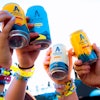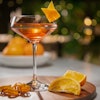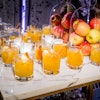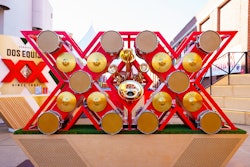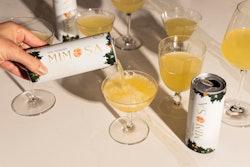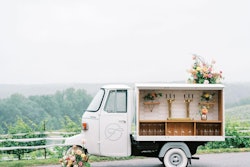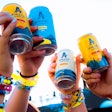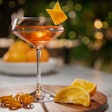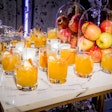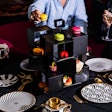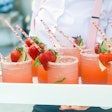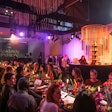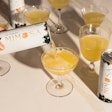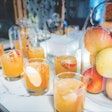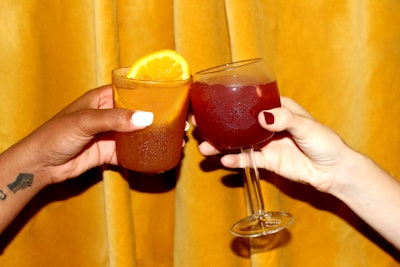
To find out what folks will be sipping in 2022, we asked beverage and hospitality experts to share their insights and predictions. From CBD-infused drinks to organic wines to nonalcoholic options, here’s what you’ll want to stock your open bars with at events and parties in the new year.
Liqueurs: “I love an Old-Fashioned and my go-to spirit is bourbon, but when you're in a professional setting, more than one whiskey drink is a recipe for disaster,” says Brian Kantor, founder of New York-based Pour My Party, a company that creates pop-up liquor tastings for events. “No one wants to be remembered as the one who had one too many. Hard seltzers, on the other hand, are light and refreshing, but carry a stigma… No one wants to be remembered as ‘basic’ either, and fairly or unfairly, hard seltzer doesn't scream ‘refined.’ Amaros and/or liqueurs mixed with soda and maybe a few other modifiers are about to make a big splash.”
!['Wild Moon in Hartford, [Conn.] is distilling some really creative liqueurs—they have a chai spice and a rose that I really like,' Kantor says.](https://img.bizbash.com/files/base/bizbash/bzb/image/2021/12/Wild_Moon_bottle_lineup.61c23224e919b.png?auto=format%2Ccompress&fit=max&q=70&w=400) "Wild Moon in Hartford, [Conn.] is distilling some really creative liqueurs—they have a chai spice and a rose that I really like," Kantor says.Photo: Courtesy of Wild Moon
"Wild Moon in Hartford, [Conn.] is distilling some really creative liqueurs—they have a chai spice and a rose that I really like," Kantor says.Photo: Courtesy of Wild Moon
Virtual mixology: “What we’re seeing increasingly is the interest in at-home mixology and bringing people’s favorite cocktails from their favorite bars and restaurants to house parties,” says Thomas Spaeth, chief cocktail officer and head of recruiting for hospitality talent at Hey Bartender. Spaeth sources bartenders and mixologists to host Hey Bartender’s virtual events.
More tequila: According to the third annual survey from BevAlc Insights by alcohol e-commerce and on-demand delivery platform Drizly, nearly 80% of retailers plan to carry more tequila next year, on par with bourbon. If tequila’s trajectory continues, sales may surpass vodka at some point next year on the platform.
“Once seen as an occasion-based drink—for Cinco De Mayo, for instance—tequila has grown to an everyday staple alongside vodka and whiskey,” explains Liz Paquette, head of consumer insights at Drizly. “Restaurant and bar closures amid the pandemic also served to fuel tequila’s growth as consumers made their favorite on-premise cocktails, like margaritas and palomas, at home. Premiumization of the category is also a larger driver, led by growth in the reposado and añejo categories as more and more high-quality brands enter the space.”
Plus, celebrity brands have helped to bring more awareness to the category; top celebrity-owned tequila brands on Drizly include Casamigos, Teremana, Codigo 1530, 818 and DeLeon. "One of the most popular ones that's frequently asked for is Casamigos, made famous by George Clooney," says Brett Sanderson, mixologist at SoBou, located at W New Orleans, French Quarter. "Only problem with Casamigos is the fact it's been extremely difficult to get a hold of any because supply issues. But nonetheless is still one of the most ordered items I've seen from behind the bar."
"We're seeing that the vodka soda has already taken a second seat to the tequila soda," says Torrence Swain, Mezcal El Silencio regional director of East Coast. "The beauty of a mezcal is that it is a spirit meant to be enjoyed in more ways than one. While it can be sipped and savored to take in the many complexities and flavors of its profile, there is absolutely no other spirit in the world that complements as large a variety of cocktail recipes as mezcal does."
 “Curious Elixirs are tackling the RTD space from the nonalcoholic angle, and their premixed mocktails are no-fuss, no-muss, with a ton of depth. Great stuff all around, and a category that I think we'll see a lot more of over the next few years,” Kantor says.Photo: Courtesy of Curious Elixirs
“Curious Elixirs are tackling the RTD space from the nonalcoholic angle, and their premixed mocktails are no-fuss, no-muss, with a ton of depth. Great stuff all around, and a category that I think we'll see a lot more of over the next few years,” Kantor says.Photo: Courtesy of Curious Elixirs
Nikki McCutcheon, beverage director of Tao Group Hospitality and the Magic Hour Rooftop Bar & Lounge at Moxy Times Square, says the venue has seen a rise in popularity with Loverboy Sparkling Hard Teas and Sip Margs cans. “Both have visually appealing packaging that make them stand out from the rest. They both also offer a unique, wide variety of flavors that set them apart from the traditional hard seltzer.”
As for hard seltzer, it’s started to lose its fizz, with brands experiencing slow growth in 2021. When it comes to ready-to-drink cocktails, Paquette says that tequila-based products are growing fast year-over-year on Drizly, adding that, in 2021 to date, nearly half of the RTD SKUs scaling fast are tequila based.
 “Wandering Barman is made by actual mixologists who sought to create bottled cocktails that tasted as wonderful as their made-to-order counterparts. So much depth in their drinks, and a far cry from the ‘Moscow Mule in a can’ that we're now seeing everywhere,” Kantor says about the RTD brand.Photo: Courtesy of Wandering Barman
“Wandering Barman is made by actual mixologists who sought to create bottled cocktails that tasted as wonderful as their made-to-order counterparts. So much depth in their drinks, and a far cry from the ‘Moscow Mule in a can’ that we're now seeing everywhere,” Kantor says about the RTD brand.Photo: Courtesy of Wandering Barman
“Mojitos are my favorite nonalcoholic cocktails to make at Magic Hour because you can incorporate so many different flavors and create a really high-end mocktail,” McCutcheon explains. “Whether you are looking for something more refreshing or fruit-forward, the mojito is very versatile.”
 Nikki McCutcheon of Tao Group Hospitality recommends the new line of craft nonalcoholic mixers, Betty Buzz, which comes in a wide variety of flavors that are made with real juice and all-natural ingredients, “making it one of the healthier options when making a mocktail.”Photo: Courtesy of Betty Buzz
Nikki McCutcheon of Tao Group Hospitality recommends the new line of craft nonalcoholic mixers, Betty Buzz, which comes in a wide variety of flavors that are made with real juice and all-natural ingredients, “making it one of the healthier options when making a mocktail.”Photo: Courtesy of Betty Buzz
Following in line with wellness trends, Swain says that "the nonalcoholic category is sure to gain more popularity as kombucha, matcha and other teas continue to find their way into beverage programs at bars and restaurants."
 “Kin and Tenneyson take more of a holistic wellness approach with ingredients meant to make you feel something better than intoxicated—and frankly, I find Tenneyson's Black Ginger to be the most satisfying neat of any of the non-alcs out there,” Kantor says.Photo: Courtesy of Tenneyson
“Kin and Tenneyson take more of a holistic wellness approach with ingredients meant to make you feel something better than intoxicated—and frankly, I find Tenneyson's Black Ginger to be the most satisfying neat of any of the non-alcs out there,” Kantor says.Photo: Courtesy of Tenneyson
According to Drizly’s report, which was a nationwide survey of over 500 alcohol retailers and incorporates sales data derived from the platform in 2021, 60% of retailers surveyed cited “organic and natural” as a non-price-related attribute that is increasingly influencing their purchasing decisions, especially for wine. “Organic, biodynamic and sustainable wines will continue to gain popularity,” Mantuano says.
Adding that local wine from smaller, lesser-known wine-producing areas in the United States like the Finger Lakes in upstate New York and Applegate Valley in Oregon will be a trend as well. Swain agrees, saying that "entry level-priced, smaller producers will continue to grow their market share. Consumers are starting to learn that a great wine is not exclusive to big name brands and more expensive price points."
Because of the shortages and price increases caused by supply chain issues on imported products, McCutcheon says that folks are drinking more domestically produced wine. “People are also warming up to less traditional style packaging such as canned wines now being produced by trusted producers giving credibility to the RTD trend,” she adds.
Speaking of supply chain…
With ongoing shortfalls in aluminum, glass and other alcoholic beverage manufacturing inputs, product shortages and supply chain issues will be the biggest challenges for the industry in 2022.
“Less so than the ingredients themselves, the bigger problem that I am hearing is a bottleneck in the bottle supply—pun intended,” Kantor says. “For American craft distilleries, the ingredients themselves are often locally grown and relatively abundant, but much of the packaging comes from overseas. The problem has an effect across the board, but it's definitely hitting the smaller distilleries harder because they are less of a priority to the bottle suppliers than the Diageos and Constellations of the world.”
Paquette adds that, with luxury tequilas in demand for the holidays, potential supply shortages may be likely into 2022 for products such as Don Julio 1942 and Clase Azul. Drizly’s report also found that 80% of retailers were at least slightly concerned about the Champagne supply running short. But Paquette said that sparkling rosé and American sparkling wines can serve as celebratory alternatives to Champs.
“Champagne and tequila have definitely been hit the hardest due to supply chain issues,” McCutcheon says. “These two beverages are traditionally made in smaller, high-quality batches and many require years to age before coming to market. With the world shutting down for some period of time and the lack of resources, we are now seeing the domino effect.”
Compounding the supply chain issues is also a lack of labor. “Last summer we struggled to get things that were already here at our docks and warehouses because there wasn’t anyone available to process and transport shipments,” Spaeth says. “If that labor shortage continues, we may see beverages of every type disappear from our shelves for a while.”
